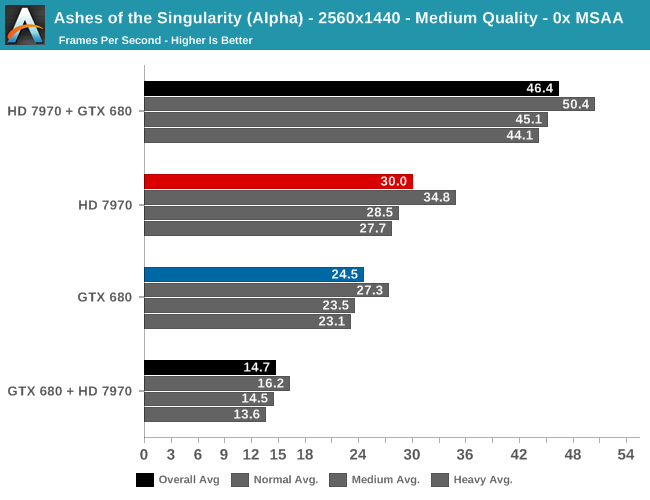GeForce + Radeon: Previewing DirectX 12 Multi-Adapter with Ashes of the Singularity
by Ryan Smith on October 26, 2015 10:00 AM ESTAshes GPU Performance: Single & Mixed 2012 GPUs
While Ashes’ mutli-GPU support sees solid performance gains with current-generation high-end GPUs, we wanted to see if those gains would extend to older DirectX 12 GPUs. To that end we’ve put the GeForce GTX 680 and the Radeon HD 7970 through a similar test, running the Ashes’ benchmark at 2560x1440 with Medium image quality and no MSAA.

First off, unlike our high-end GPUs there’s a distinct performance difference between our AMD and NVIDIA cards. The Radeon HD 7970 performs 22% better here, just averaging 30fps to the GTX 680’s 24.5fps. So right off the bat we’re entering an AFR setup with a moderately unbalanced set of cards.
Once we do turn on AFR, two very different things happen. The GTX 680 + HD 7970 setup is an outright performance regression, with performance 40% from the single GTX 680 Ti. On the other hand the HD 7970 + GTX 680 setup sees an unexpectedly good performance gain from AFR, picking up a further 55% to 46.4fps.
As this test is a smaller number of combinations it’s not clear where the bottlenecks are, but it’s none the less very interesting how we get such widely different results depending on which card is in the lead. In the GTX 680 + HD 7970 setup, either the GTX 680 is a bad leader or the HD 7970 is a bad follower, and this leads to this setup spinning its proverbial wheels. Otherwise letting the HD 7970 lead and GTX 680 follow sees a bigger performance gain than we would have expected for a moderately unbalanced setup with a pair of cards that were never known for their efficient PCIe data transfers. So long as you let the HD 7970 lead, at least in this case you could absolutely get away with a mixed GPU pairing of older GPUs.










180 Comments
View All Comments
xjointsx - Monday, October 26, 2015 - link
Now i can imagine AMD & Nvidia GPU in 1 PCB Card.GTR9 Futan X.
Refuge - Tuesday, October 27, 2015 - link
+1at80eighty - Monday, October 26, 2015 - link
great. now the video card forums arent going to be as fun anymore T_Tajmiles - Monday, October 26, 2015 - link
I wouldn't normally post a comment just to correct a typo, but as a Rendering Engineer by day, the idea of a "rendering implantation" was too good to pass up (page 3). Sounds very sci-fi!silverblue - Tuesday, October 27, 2015 - link
Yes, but you obviously forgot to invert the polarity, realign the phase inducers with the ODN matrices AND do the hokey-cokey.moozoo - Monday, October 26, 2015 - link
How fine grain is their assignment of work load to the different cards?If amd is faster at doing X and nvidia is faster at doing Y. then but putting more X work to the AMD card and more Y work to the Nvidia card you would expect the result to be faster than two cards that are the same.
i.e. two AMD cards would be bottle necked by the Y work and two Nvidia cards would be bottle necked doing the X work.
Kodiack - Tuesday, October 27, 2015 - link
"YouTube limits 60fps videos to 1080p at this time."Fortunately, this is no longer the case. As of a few months ago, you can even watch 4K60 content on YouTube! Your videos are currently showing as 1440p60, and they look wonderful for it.
Chaython - Tuesday, October 27, 2015 - link
Excuse me, how does a high end stack up with a low end? does it downgrade the high end [as with previous bridging,] or will it actually perform better than just the high cardie, 970 + 6700k IGPU
CiccioB - Tuesday, October 27, 2015 - link
As it is AFR (alternate frame rendering) where each GPU completes an entire frame on its own, that king of mix will simply, at best, double the performances of the iGPU, keeping the beefy GPU sleeping most of the time waiting for the iGPU to finish its work.Intel999 - Tuesday, October 27, 2015 - link
The ability to mix GPUs bodes well for AMD in that on the laptop front an APU can be mixed with any discrete GPU. This will, theoretically, make a moderately priced laptop perform well above entry level gaming on the cheap. Better than an Intel Igpu since their graphics don't bring much to the party unless you are willing to pay top dollar for the highest end Igpu that only matches AMDs cheaper APUs.